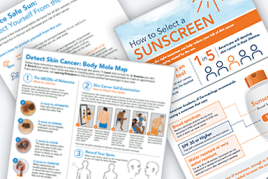Pityriasis rosea: FAQs
What is pityriasis rosea?
It’s a common condition that causes a rash on the skin. This rash is harmless and usually lasts 6 to 8 weeks before disappearing. While harmless, getting a diagnosis can be important. This rash may look like ringworm, psoriasis, or eczema, which often require treatment. A board-certified dermatologist can tell you what’s causing your rash.
Is pityriasis rosea contagious?
Many patients ask if it’s sexually transmitted. It’s not. In fact, it’s not contagious. You cannot catch it from another person, and you cannot spread it to others.
How do you get pityriasis rosea?
While the exact cause remains unknown, research suggests that a virus causes this skin condition. We know that some people get pityriasis rosea after they’ve had an illness caused by a virus.
Pityriasis rosea
This condition often begins with one large patch called a herald patch (indicated with the arrow). A widespread rash, like the one shown here, usually follows.

Who gets pityriasis rosea?
You’re most likely to get pityriasis rosea between 10 and 35 years of age; however, this condition can occur at any age. People around the world develop it, and pityriasis rosea affects folks of all skin tones. Most people who get this skin condition are otherwise healthy.
This condition can occur during pregnancy. If you develop pityriasis rosea while you’re pregnant, let your obstetrician know. Some studies have found that having pityriasis rosea during pregnancy can affect the baby. Other studies have not found this. However, your obstetrician may want to follow you more closely.
It's also possible to develop a rash that looks like pityriasis rosea after you take a medication or get a vaccine. This rash isn’t pityriasis rosea. It’s caused by a reaction to the medication or vaccine. Medications that can cause this include terbinafine (antifungal medication), naproxen (aspirin alternative), and captopril (treats high blood pressure and heart disease).
Is there a cure for pityriasis rosea?
No, there isn’t a cure. You can take comfort in these facts:
The rash goes away on its own.
Many people get pityriasis rosea once. That’s right. After the rash clears, many people never develop the condition again.
Can you prevent pityriasis rosea?
Because we don’t know the exact cause, you cannot prevent this skin condition.
If the rash or symptoms cause you discomfort, you can often get relief by treating it at home. If symptoms are especially bothersome, you can see a dermatologist for treatment.
Will the rash cause a scar?
Pityriasis rosea usually clears without leaving scars.
Some people with darker skin tones develop dark or light spots after the rash clears. These spots are not scars and will go away in time. If the dark spots develop on skin that gets exposed to the sun, like your arms or neck, the dark spots may take months to fade.
If lingering dark or light spots bother you, ask your dermatologist about treatment options.
Can you prevent the rash from spreading?
No. Pityriasis rosea develops in stages. It often begins with a single round or oval, slightly raised patch that appears on the skin. This patch is called a “herald patch” or “mother patch.” A few days to a few weeks later, many people see a widespread rash.
There is no way to prevent this widespread rash. Pityriasis rosea will run its course, and then go away without causing any health problems.
You’ll find more information about how the rash develops and clears, along with symptoms you may experience, at Pityriasis rosea: Signs and symptoms.
Image
Image used with permission of the Journal of the American Academy of Dermatology.(J Am Acad Dermatol 2009;61:303-18.)
References
Clark M, Gudjonsson JE. “Pityriasis rosea.” In: Kang S, Amagai M, et al. Fitzpatrick’s Dermatology (ninth edition). McGraw Hill Education, New York, 2019: 518-26.
Drago F, Broccolo F, et al. “Pityriasis rosea: An update with a critical appraisal of its possible herpesviral etiology.” J Am Acad Dermatol. 2009 Aug;61(2):303-18.Goldstein AO, Goldstein BG. (section editors: Dellavalle RP, Levy ML). “Pityriasis rosea.” UpToDate. Last reviewed: 8/2024. Last accessed: 9/2024.
Heymann WH. “A clinician’s perspective: Probing pityriasis rosea in pregnancy,” J Am Acad Dermatol. 2021 Dec;85(6):1413.
Leung AKC, Lam JM, et al. “Pityriasis rosea: An updated review.” Curr Pediatr Rev. 2021;17(3):201-11.
Litchman G, Nair PA, et al. “Pityriasis rosea.” StatPearls. Last updated 3/1/2024. Last accessed 9/2024.
Wood GS, Reizner GT. “Other papulosquamous disorders.” In: Bolognia JL, et al. Dermatology. (fourth edition). Mosby Elsevier, China, 2018:170-2.
Zabel M, Hile GA, et al. “Dupilumab-induced pityriasis rosea.” JAAD Case Rep. 2023 Jan 6;33:27-9.
Written by:
Paula Ludmann, MS
Reviewed by:
Brendan Camp, MD, FAAD
William Warren Kwan, MD, FAAD
Ata Moshiri, MD, FAAD
Carla Torres-Zegarra, MD, FAAD
Last updated: 10/24/24
 Atopic dermatitis: More FDA-approved treatments
Atopic dermatitis: More FDA-approved treatments
 Biosimilars: 14 FAQs
Biosimilars: 14 FAQs
 How to trim your nails
How to trim your nails
 Relieve uncontrollably itchy skin
Relieve uncontrollably itchy skin
 Fade dark spots
Fade dark spots
 Untreatable razor bumps or acne?
Untreatable razor bumps or acne?
 Tattoo removal
Tattoo removal
 Scar treatment
Scar treatment
 Free materials to help raise skin cancer awareness
Free materials to help raise skin cancer awareness
 Dermatologist-approved lesson plans, activities you can use
Dermatologist-approved lesson plans, activities you can use
 Find a Dermatologist
Find a Dermatologist
 What is a dermatologist?
What is a dermatologist?